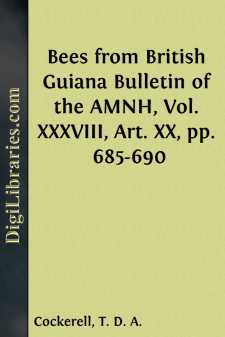Categories
- Antiques & Collectibles 13
- Architecture 36
- Art 48
- Bibles 22
- Biography & Autobiography 813
- Body, Mind & Spirit 142
- Business & Economics 28
- Children's Books 15
- Children's Fiction 12
- Computers 4
- Cooking 94
- Crafts & Hobbies 4
- Drama 346
- Education 46
- Family & Relationships 57
- Fiction 11828
- Games 19
- Gardening 17
- Health & Fitness 34
- History 1377
- House & Home 1
- Humor 147
- Juvenile Fiction 1873
- Juvenile Nonfiction 202
- Language Arts & Disciplines 88
- Law 16
- Literary Collections 686
- Literary Criticism 179
- Mathematics 13
- Medical 41
- Music 40
- Nature 179
- Non-Classifiable 1768
- Performing Arts 7
- Periodicals 1453
- Philosophy 64
- Photography 2
- Poetry 896
- Political Science 203
- Psychology 42
- Reference 154
- Religion 513
- Science 126
- Self-Help 84
- Social Science 81
- Sports & Recreation 34
- Study Aids 3
- Technology & Engineering 59
- Transportation 23
- Travel 463
- True Crime 29
Bees from British Guiana Bulletin of the AMNH, Vol. XXXVIII, Art. XX, pp. 685-690
Description:
Excerpt
In connection with the work of the Tropical Research Station of the New York Zoological Society, conducted by Mr. William Beebe, collections of insects, including bees, were made. The present report deals with a series of bees from the Bartica District, and Mr. John Tee Van, in forwarding them, states that "almost all of these bees were procured about a clump of several species of nightshades (Solanum), which were flowering in thinned-out jungle." I give an artificial key, which will enable one who is not a specialist in bees to separate readily each species from the rest. It will, of course, remain necessary to compare any species with a fuller account to make sure that it is not some form unrepresented in the present collection. The types of the new species and varieties from British Guiana are deposited in The American Museum of Natural History. Species marked P. are from the Penal Settlement; those marked K. occur at Kalacoon.
The body, or some part of it, brilliant greenNo part of the body brilliant green1.
11.1.Thorax dark, with more or less purple tints, not bright green
Thorax bright or clear green, at least in part2.
4.2.Small bee, less than 10 mm. long
Large, robust bees, greatly exceeding 10 mm.Augochlora callichlorura, new species.
3.3.Abdomen with the first two segments dark; tongue not extending to end of abdomen
Abdomen all bright green, with brassy tints; tongue extending backward far beyond tip of abdomenEufriesia pulchra(Smith).
Euglossa brulleiLepeletier.4.Hind margins of abdominal segments broadly black.
Hind margins of abdominal segments green
Hind margins of abdominal segments red or whitish; very robust beesAugochlora nigromarginata(Spinola).âP.
5.
10.5.Small bee, less than 10 mm. long, the clypeus with a transverse apical ivory-colored band
Larger, very robust beesCeratina l?taSpinola.
6.6.Tongue extending beyond abdomen posteriorly
Tongue not extending beyond abdomen7.
8.7.Scutellum with a patch of black tomentum
Scutellum without a patch of black tomentumEuglossa ignitaSmith; female.
Euglossa ignitaSmith; male.8.Robust bees, about 10 mm. long or a little over; scutellum with, a patch of black tomentum
Much larger bees, a little over 20 mm. longEuglossa cordata(Linn?us).âP.
9.9.Scutellum with an obtuse median keel; posterior angles of scutellum rounded
Scutellum depressed in middle, without any keel; posterior angles of scutellum rather prominentEx?rele smaragdina(Guerin).
Ex?rele dentata(Linne).10.Scutellum with a patch of light fulvous tomentum; scape red.
Scutellum with a patch of black tomentum; scape dark, with a pale yellow mark
Scutellum without a patch of tomentum; scape pale yellow in front.Euglossa decorata ruficauda, new variety; femaleâK.
Euglossa singularisMocsary.âP.
Euglossa decorata ruficauda, new variety; male.11.Very large bees, anterior wing at least 23 mm. long; integument partly or wholly ferruginous
Anterior wing less than 20 mm. long12.
13.12.Abdomen with broad black bands.
Abdomen without black bandsXylocopa frontalis nitens(Lepeletier); maleâP.
Xylocopa fimbriala(Fabricius).13.Wasp-like bee, with fusiform abdomen, reddish wings and red legs; three complete submarginal cells,
first recurrent nervure meeting second transversocubital
Otherwise formed, the abdomen broad at baseRhathymus beebei, new species
14.14.Surface of eyes with fine short hair; first abdominal segment red, the others black; female abdomen sharply pointed.
Eyes not hairy; female abdomen not sharply pointedC?lioxys ardescensCockerell. (Hym. 6 and 138.)
15.15.Anterior wings with three complete submarginal cells
Anterior wings with submarginal cells incomplete or wanting; stingless social bees16.
29.16.Small bee, about 8 mm. long; wings beyond middle milky-white, the extreme apex dusky
Larger bees; the wings not thus coloredTetrapedia lacteipennisVachal.âP.
17.17.Abdomen clear ferruginous; large robust bees
Abdomen not ferruginous; or only partly so18....


